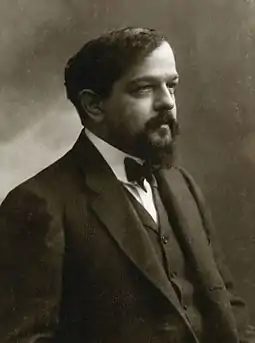Trois Chansons (Debussy)
Trois Chansons (French for "Three Songs"), or Chansons de Charles d’Orléans, L 99 (92), is an a cappella choir composition by Claude Debussy set to the medieval poetry of Charles, Duke of Orléans (1394-1465). Debussy wrote the first and third songs in 1898 and finished the second in 1908. He premiered the piece in 1909 and Trois Chansons is his only composition for unaccompanied choir.
| Trois Chansons | |
|---|---|
| Choral music by Claude Debussy | |
 The composer in 1908 | |
| English | Three songs |
| Catalogue | L 99 (92) |
| Text | Poems by Charles, Duke of Orléans |
| Composed | 1898, 1908 |
| Performed | 11 March 1909 |
| Published | 1909 |
| Scoring | A cappella choir |
History
Using the poetry of medieval poet Charles, Duke of Orléans, the first and third songs were revised from an earlier version composed in 1898 for a choir belonging to his friend Lucien Fontaine.[1][2] He finished the second song in 1908 and the completed Trois Chansons was published by Auguste Durand the same year.[3] The first performance was in March 1909 with eight singers from the Engel-Bathori choir.[3] The following month, he conducted the piece at Concerts Colonne along with his composition La Damoiselle élue.[3] Dying nine years after the premiere of Trois Chansons, it is his only composition for unaccompanied choir.[1]
Texts and music
All songs are scored for a four-part unaccompanied mixed chorus, except for Quand j'ai ouy le tambourin sonner, which is set for alto soloist and alto-tenor-bass.[4] His choice of Renaissance song techniques and use of romantic texts from the past was a neoclassical trend at the time of composition.[1][4] The Renaissance devices he integrated into this twentieth-century composition includes the modality and equal-voice polyphony.[5] Each piece is in ternary form, the beginning of each is repeated at the end and features Debussy's signature use of non-functional dominant seventh chords and half-diminished seventh chords (functioning as an incomplete dominant ninth).[4][5]
The poetry is set in ballade form, consisting of three or four stanzas and a refrain.[4] There is an unchanging meter and equal number of syllables in each piece.[4] Thematically, the poems are unrelated.
I. Dieu! qu'il la fait bon regarder!
The key signature features five sharps, normally indicating a B major or G-sharp minor scale.[6] However, due to Debussy's oscillating harmonies between F-sharp major and C-sharp minor, the music is in neither key.[6] Debussy asserts the tonic is F-sharp and the minor dominant is C-sharp, with the Mixolydian mode beginning on F-sharp.[6] The poem is a lovers expression for his mistress.[4]
II. Quand j'ai ouy le tambourin sonner
The key is F-sharp minor with the dominant chords inflections being largely based on an Aeolian mode.[5] The tempo gives the feeling of a romantic dance piece.[5] The alto-soloist is singing about how they would "rather stay warm in bed while everyone else is out enjoying May-time celebrations" while the other three voices mimic the percussion sound of a tambourin.[7] The speaker in the poem is presumably male, so there is a mystery in the differences of the published edition assigning the solo to a contralto, whereas the manuscript designates it for tenor.[1]
III. Yver, vous n'estes qu'un villain
The key signature is E-minor.[5] The poem is a denunciation of winter's harsh cold and the musical mode is Mixolydian.[4]
References
- "Trois Chansons de Charles d'Orléans, L99" (PDF). Hyperion Records. 1992. Retrieved 2019-03-09.
- "Biography: 1894-1902". Centre de documentation Claude Debussy. Retrieved 2019-03-09.
- "Biography: 1903-1909". Centre de documentation Claude Debussy. Retrieved 2019-03-09.
- Shearin, Arthur (1979). "The Choral Music of Debussy and Ravel". The Choral Journal. 19 (6): 7–9. JSTOR 23545236.
- Jacobson, Joshua (1988). "Debussy's "Trois Chansons" An Analysis". The Choral Journal. 28 (9): 5–10. JSTOR 23547465.
- Alwes, Charles (2016). A History of Western Choral Music. 2. New York, New York: Oxford University Press. pp. 121–122. ISBN 978-0-19-517742-8.
- Ivan, Hewett (2013-09-05). "Ivan's Classic 50 No 37: Debussy – Cloches à travers les feuilles from Images". The Telegraph. Retrieved 2019-03-09.
External links
Free scores of Trois Chansons by Claude Debussey in the Choral Public Domain Library (ChoralWiki)